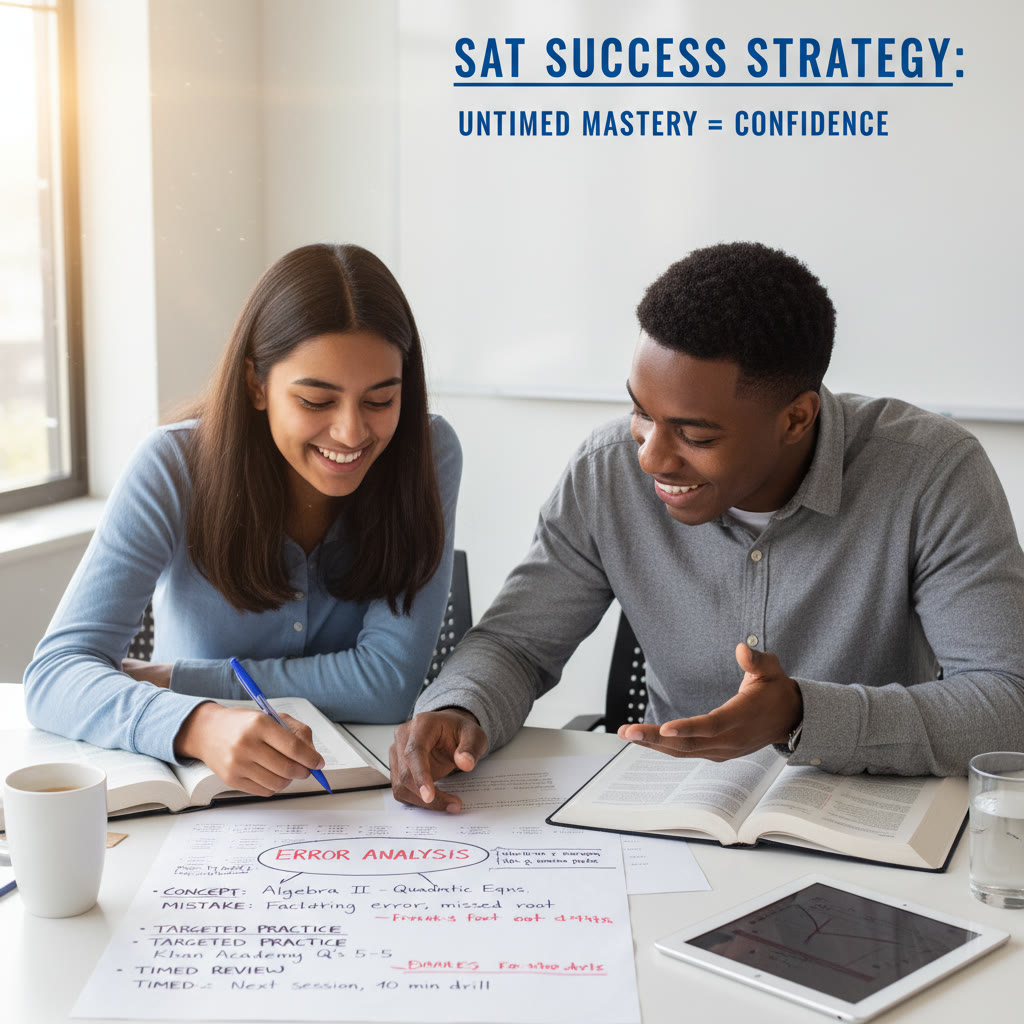Introduction: Why the question of timing matters
When you’re two months away from the SAT, the word “timed” shows up everywhere—timed sections, timed drills, timed full-lengths. It feels like the clock is the enemy, and sometimes it is. But timing in practice isn’t an either/or choice. Think of timed and untimed practice as two different tools in a toolkit. Each does something the other cannot. Used together, they transform confusion into confidence and careless mistakes into steady improvements.
In this post we’ll explore the differences between timed and untimed SAT prep, when to use each approach, how to structure practice sessions, and concrete, actionable tips to get the best from both. Along the way I’ll share examples, sample schedules, and even a table you can use to plan the next six weeks before your test. You’ll also see how Sparkl’s personalized tutoring — with one-on-one guidance, tailored study plans, expert tutors, and AI-driven insights — can slot into both styles of practice to accelerate progress.
The basic difference: speed versus mastery
What timed practice does for you
Timed practice simulates the real test day. It builds pacing, stamina, and a sense of when to move on. A timed full-length test trains your body and brain to focus for three hours; smaller timed drills teach you how long to spend on a Reading passage or a Math problem before deciding to skip. The most important benefit: it uncovers time-management weak points you might not notice in leisurely study.
- Simulates test pressure and pacing
- Identifies sections or question-types that eat time
- Builds endurance for long sittings
- Teaches triage—when to skip and when to grind
What untimed practice does for you
Untimed practice is the laboratory. It’s where you slow down and learn the mechanics of questions: how to parse a dense reading passage, why a math step works, or how grammar rules apply in a tricky sentence. Untimed work focuses on accuracy, strategy refinement, and deep conceptual understanding without the clock hovering overhead.
- Strengthens foundational skills
- Allows detailed error analysis and targeted review
- Encourages experimentations with methods (e.g., plugging in numbers, diagramming)
- Reduces early-test anxiety by building confidence
How the SAT is timed: quick facts you should know
Understanding how time is distributed on the actual SAT helps you design both timed and untimed practice. The standard SAT testing time is 3 hours (180 minutes) split across four sections:
- Reading: 65 minutes (5 passages; about 13 minutes per passage)
- Writing & Language: 35 minutes (44 multiple-choice questions)
- Math (No Calculator): 25 minutes (20 questions)
- Math (Calculator): 55 minutes (38 questions)
These numbers give you a baseline for per-question pacing. For example, Reading averages roughly 75 seconds per question, while Writing & Language puts you at roughly 48 seconds per question. Knowing these averages is useful, but remember: the SAT is passage-driven, and that changes how you allocate time in practice.
When to start with untimed practice
Early stages of prep (first 4–6 weeks)
When you’re just beginning, untimed practice should dominate. At this stage you’re building vocabulary, grammar instincts, algebra fluency, and translating those half-remembered rules into automated steps. Untimed drills let you:
- Slowly parse questions and identify recurring traps
- Try multiple strategies for solving a problem, then choose the most efficient
- Do careful error analysis and record patterns (e.g., careless arithmetic mistakes, misreading question stems)
Example: If a student repeatedly misses questions about conditional probability, untimed practice allows step-by-step retracing of their thinking, teaching them how to translate words into equations without the stress of the timer.
Targeted review after practice tests
Always pair your timed full-lengths with untimed review. The test exposes the mistakes; untimed review explains them. Spend time reworking every incorrect problem, line-by-line. Identify whether each miss was a knowledge gap, a careless error, or a timing decision gone wrong.
When to shift to timed practice
When you can solve problems accurately
Once your accuracy is consistently improving in an untimed setting, it’s time to introduce the clock. A good rule of thumb: start timed drills when you can correctly solve a set of practice questions untimed about 80–85% of the time. Timed practice converts accuracy into fluency.
Two to four weeks before the test
In the final month, your focus should move sharply toward timed full-length practice. Simulate testing conditions: strict timing, minimal interruptions, scheduled breaks, and the same question order. Full-length timed tests do more than measure your score—they train pacing, endurance, and mental resilience.
How to structure a practical blend: a 6-week plan
Below is a realistic six-week plan for a student who starts with intermediate knowledge and has a target score to reach. The layout alternates untimed mastery and timed simulation so you don’t lose precision for speed.
| Week | Focus | Practice Split (Untimed : Timed) | Key Activities |
|---|---|---|---|
| 1 | Foundations | 80% : 20% | Untimed concept drills (algebra, grammar rules), error log setup, light timed section (1 Reading passage) |
| 2 | Technique & Strategy | 70% : 30% | Untimed targeted practice, begin pacing drills for Writing & Language and Math No Calculator |
| 3 | Integration | 50% : 50% | Half-length timed sections, focused untimed review of errors, stamina workouts (90–120 minute sits) |
| 4 | Full assembly | 40% : 60% | Full-length timed practice test (1–2), untimed deep dives on weak areas |
| 5 | Sharpening | 30% : 70% | Multiple timed tests, pacing drills, psychological tactics (breathing, micro-breaks) |
| 6 | Peak & Taper | 20% : 80% | Final timed practice test simulation, light untimed review, rest, test-day checklist |
This plan is a template. Sparkl’s personalized tutoring teams often adapt similar structures but adjust the percentages and activities based on a student’s baseline, strengths, and test date. Their tutors bring one-on-one guidance and AI-driven insights to identify which weeks need heavier untimed remediation or more timed repetitions.
Concrete strategies for timed practice
Pacing rules of thumb
- Reading: Aim for roughly 13 minutes per passage. If a passage is taking more time, practice skimming for the big picture and answering detail questions more quickly.
- Writing & Language: Treat this as high-volume, low-weight. You have about 48 seconds per question; train for pattern recognition—grammar rules repeat often.
- Math No Calculator: 25 minutes for 20 questions. Practice doing rapid calculations and skipping early if a problem is algebraically dense.
- Math Calculator: 55 minutes for 38 questions. Use a triage system: fast problems first, medium ones next, save the long multi-step problems for the end.
Smart skipping
Timed practice should teach you when to move on. A good rule: if a question hasn’t yielded after two minutes in Math or after one reasonable pass through a Reading question, mark it and keep going. Marking preserves time and leaves room to return with fresh energy.
Simulate the test environment
Put away your phone, use the real test timing, and include the recommended breaks. Simulated stress is part of the training—the more realistic you make it, the more reliable your timing on test day. If you work with a tutor from Sparkl, they’ll often run proctored practice sessions to replicate test conditions and provide immediate feedback on pacing choices.
Concrete strategies for untimed practice
Microscopic error analysis
Untimed practice is where you get forensic with your mistakes. For each wrong answer, write: why you missed it, the correct approach, and one thing you’ll do differently next time. Over time you’ll see patterns—not just topics, but process patterns like misreading the last clause of a sentence or mismanaging parentheses.
Technique experiments
Use untimed drills to test alternative strategies. For example, in Reading, try timing-free passage mapping (summarizing each paragraph in a few words). In Math, practice solving algebra problems both symbolically and by plugging in numbers to see which is faster and more reliable for you.
How to combine both styles for best results
Balance is the name of the game. Here’s a practical cycle you can use weekly:
- Days 1–2: Untimed mastery on weaknesses (deep practice with error analysis).
- Day 3: Timed section drills (one or two sections under test conditions).
- Day 4: Untimed review of the timed drills—rework mistakes slowly.
- Day 5: Mixed practice (short untimed drills + short timed drills).
- Day 6: Full-length timed practice (every other week) or two half-tests.
- Day 7: Rest or light review (flashcards, vocabulary, or mental resets).
That weekly rhythm keeps growth steady: you learn and consolidate without letting timing overwhelm the learning process.
Mindset and stress management
From panic to process
Timing often triggers panic. The antidote is process focus: instead of obsessing about the remaining minutes, focus on the next decision—read the next question, eliminate two choices, or set up the equation. Small, repeatable processes reduce cognitive load and keep you on track.
Stamina training
Timed practice isn’t just mental; it’s physical. Long tests require sustained attention. Build up sitting stamina with longer study blocks, proper posture, hydration, and mock test snacks. The body and brain are partners—treat them that way.
Sample timed-test day checklist
- Full warm-up: light review of formulas and grammar patterns, 15–20 minutes max.
- Proper sleep the night before (7–9 hours).
- Nutritious breakfast that’s not heavy: protein + complex carbs.
- Arrive early and have your test materials organized.
- During the test: use your timing plan, mark and move on, breathe during breaks.
How Sparkl’s personalized tutoring fits into timed and untimed prep
Personalized tutoring amplifies both modes of practice. With one-on-one guidance, a tutor can watch your solutions in an untimed setting and immediately correct process flaws. They can also run timed simulations and provide feedback on pacing decisions that you might not notice alone. Sparkl’s tutors combine human coaching with AI-driven insights to spot patterns in mistakes, recommend which problems to untimed-drill, and tell you when you’re ready to intensify timed practice.
For example, your tutor might notice you consistently lose time in Reading on inference questions. They’ll design targeted untimed exercises to teach an inference checklist and then set timed passage drills to convert that checklist into a rapid habit. That cycle—diagnose, remediate untimed, consolidate timed—is how students turn weak spots into reliable strengths.
Common pitfalls and how to avoid them
- Rushing into timed tests too early: You’ll build bad habits. Start with mastery then add the clock.
- Practicing timed tests without reflective review: Timed tests are diagnostic only if you follow them with deep untimed analysis.
- Using every timed test as score-focused: Some should be learning-focused; not every full-length needs to be a “maximal performance” run.
- Ignoring mental and physical prep: Timing training without stamina work leads to fading toward the end of the test.
Final example: A math question handled two ways
Imagine this algebra problem: “If 3(2x – 1) = 4x + 5, what is x?”
Untimed approach: work carefully—distribute: 6x – 3 = 4x + 5; subtract 4x: 2x – 3 = 5; add 3: 2x = 8; x = 4. Note every step to avoid sign errors.
Timed approach: recognize the pattern and reduce steps: 3(2x – 1)=4x+5 -> 6x-3=4x+5 -> 2x=8 -> x=4. In a timed drill you practice skipping written intermediate steps when safe, but only after untimed mastery has made the process reliable.
Takeaway: timing is a dial, not a switch
The difference between timed and untimed SAT prep is not which is better; it’s which is better for the job at hand. Use untimed practice to build accuracy, reasoning, and strategy. Use timed practice to convert those skills into speed, pacing, and endurance. Alternate them deliberately. Reflect after every timed session with careful untimed review. Gradually shift toward more timed practice as your test date approaches, and don’t forget to train stamina, stress management, and test-day routines.
If you want a tailored schedule, targeted problem sets, and someone to analyze your timing choices with you, Sparkl’s personalized tutoring offers one-on-one guidance, tailored study plans, expert tutors, and AI-driven insights to make every minute of practice count. With thoughtful blending of timed and untimed work, your improvement becomes not just a possibility but a plan.


Ready to design your next six weeks?
Start by assessing your current accuracy in an untimed environment, pick one weak topic for untimed mastery, and schedule your first timed section drill by the end of the week. Keep a notebook for timing notes and mistakes. If you’d like hands-on help, consider structured sessions with a Sparkl tutor who can build and adjust your plan as you improve. Timing becomes less intimidating once you turn it into a deliberate training instrument—one practice session at a time.
Good luck. Keep the clock in perspective: it’s not the enemy—it’s a coach that, when used wisely, helps you perform your best on the day that matters.






















No Comments
Leave a comment Cancel